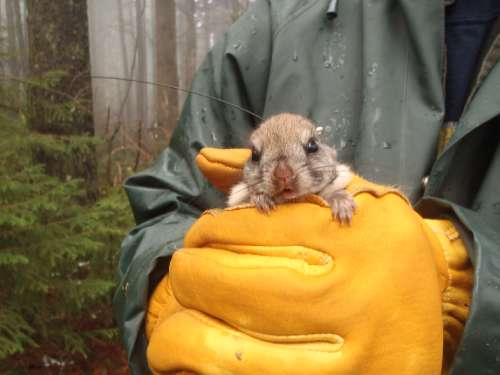Habitat loss has fragmented the population of the Carolina northern flying squirrel, an endangered species now living on “sky-islands” on nine isolated mountain peaks in the southern Appalachians.
A new study published in Endangered Species Research provides resource managers with a predictive map, based on U.S. Geological Survey led modeling efforts, that can help as they work to better define, protect and enhance the endangered squirrels’ habitat.
“The strength of our modeling is that it allows resource managers and other researchers to account for Carolina northern flying squirrels without having to catch them in traps or artificial nest-boxes, activities that are time-consuming and logistically difficult to undertake,” said W. Mark Ford, an USGS scientist at the Virginia Cooperative Fish and Wildlife Research Unit at Virginia Tech and lead author of the study. “Our findings can be used by resource managers to prioritize forest areas that are habitat for this sub-species.”
The Carolina northern flying squirrel is found in the mountains of western North Carolina, eastern Tennessee, and southwestern Virginia. The squirrel is typically found in altitudes above 1,385 meters (about 4,500 feet) in habitats of mixed hardwood such as eastern hemlock, northern hardwood-red spruce and red spruce-Fraser fir. This rare animal is restricted to high elevation “sky-islands” that were reduced in size and quality by logging and fire in the late 19th through the mid-20th century. Because of its limited and disjointed range, the squirrel is vulnerable to human and natural threats.
Currently, the high-mountain forests that the squirrel inhabits are threatened by exotic insects, forest fragmentation/second-home development on private land, climate change and atmospheric deposition—which is when pollutants in the atmosphere are deposited on land or water.
“In addition to helping resource managers understand where squirrels occur on the landscape, our newly developed map highlights where to consider red spruce ecosystem restoration,” said Ford. “This restoration could be done to repair impacts from past logging and to promote forest resilience in the face of climate change over the next 100 years. Southern Appalachian red spruce-Fraser fir forests are among the most imperiled forest ecosystems in North America and are believed to be highly vulnerable to climate change impacts.”
The nocturnal squirrel is largely vegetarian and eats lichens, fungi, and occasionally fruits and nuts. When available, they may also dine on bird eggs, bird nestlings and crayfish. Active year round, they nest in tree cavities, and small groups of squirrels will often occupy the same tree cavity in the colder winter months.
“The squirrels need red spruce forests for their habitat, where they persist largely consuming the fruiting bodies of mycorrhizal fungi, more commonly known as ‘truffles,’” Ford said. “Conversely, the red spruce forests need the squirrels to help disperse the spores of these truffles that the forest’s trees need for nutrients.”
The research team included scientists from the USGS, Virginia Tech, Texas A&M, U.S. Forest Service Northern Research Station, U.S. Fish Wildlife Service Raleigh Field Office and North Carolina Wildlife Resources Commission. They looked at long-term nest-box data collected by the North Carolina Wildlife Resources Commission, the U.S. Forest Service, the National Park Service, the U.S. Fish and Wildlife Service and the Cherokee Nation to develop “occupancy” models.
Forest habitats associated with inhabited nest boxes were modeled across the entire southern Appalachian landscape, including vast roadless tracts in the Great Smoky Mountains National Park and national forest wilderness areas where surveys would be unlikely to occur.
The article, Predictive Habitat Models Derived from Nest-box Occupancy for the Endangered Carolina Northern Flying Squirrels in the Southern Appalachians, is available online in Endangered Species Research.

